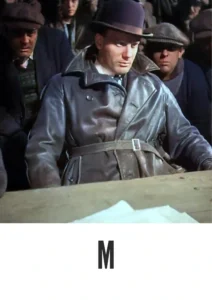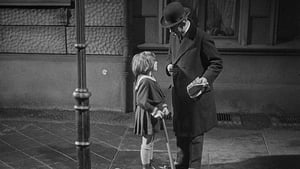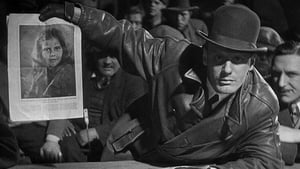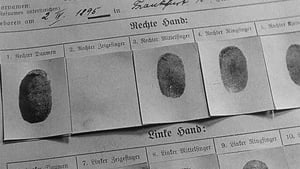Contact: info@alwanfilm.com
Video Sources 0 Views
- Watch trailer
- M 1932

Synopsis
Table of Contents
ToggleReview: M 1932 Colorized – A Landmark Thriller That Defies Time

Introduction
“M” (1932) stands as a seminal work in cinematic history, a landmark thriller that continues to captivate audiences with its haunting imagery and chilling portrayal of a city gripped by fear. In this review, we’ll delve into the significance of “M” (1932), exploring its enduring impact on the world of cinema and its timeless relevance in today’s society.
Check The Full Colorized Movies List
Check Our Colorized Movies Trailer Channel
Understanding M 1932 Colorized: Director, Cast, and Genre
Directed by the visionary Fritz Lang, “M” (1932) showcases his mastery of suspense and psychological tension, cementing his reputation as one of the greatest filmmakers of the silent era. The film features a powerhouse performance by Peter Lorre in the role of a deranged child murderer, whose reign of terror sends shockwaves through the city streets. Blending elements of horror, crime, and noir, “M” (1932) transports viewers to a world of shadows and secrets, where danger lurks around every corner.
Exploring the World of M 1932 Colorized: Plot and Characters
At its core, “M” (1932) follows the desperate hunt for a serial killer who preys on young children, sending the city into a state of panic and paranoia. As the police close in on their elusive quarry, a shadowy network of criminals takes matters into their own hands, launching a manhunt of their own. Along the way, we meet a cast of characters whose lives intersect in unexpected ways, from a grieving mother seeking justice to a beguiling underworld figure with secrets of his own.
The Art of Film Noir
“M” (1932) is often credited as one of the earliest examples of film noir, a genre characterized by its dark themes, morally ambiguous characters, and atmospheric cinematography. Through its use of shadow and light, “M” (1932) creates a palpable sense of dread and unease, drawing viewers into its sinister world and keeping them on the edge of their seats until the final frame.
Early Crime Thrillers: A Brief History
The history of crime thrillers traces its roots back to the silent era, with filmmakers experimenting with various techniques to ratchet up the tension and suspense. From Alfred Hitchcock’s “The Lodger” to F.W. Murnau’s “Nosferatu,” the genre has evolved over the years, incorporating elements of horror, mystery, and psychological drama to create a rich tapestry of cinematic experiences.
M 1932 and Its Enduring Legacy
“M” (1932) has left an indelible mark on the world of cinema, inspiring generations of filmmakers and scholars with its groundbreaking storytelling and innovative techniques. From its pioneering use of sound to its unflinching exploration of taboo subjects, the film continues to captivate audiences with its timeless themes and timeless relevance.
Director’s Cinematic Legacy: Beyond M 1932 Colorized
Fritz Lang’s influence extends far beyond “M” (1932), with a diverse body of work that continues to captivate audiences around the globe. From “Metropolis” to “The Big Heat,” Lang’s films are celebrated for their bold visual style, complex characters, and provocative themes, solidifying his legacy as one of the most influential filmmakers of the 20th century.
Themes Explored in M 1932 Colorized
“M” (1932) explores a myriad of themes, from the nature of evil to the limits of justice in a society teetering on the brink of chaos. Through its gripping narrative and unforgettable imagery, the film invites viewers to confront the darkest corners of the human psyche and grapple with the moral complexities of crime and punishment.
Reception and Controversy Surrounding M 1932 Colorized
Upon its release, “M” (1932) received widespread critical acclaim, with many praising its innovative storytelling, atmospheric cinematography, and Peter Lorre’s unforgettable performance as the deranged child murderer. However, the film also sparked controversy for its provocative subject matter and disturbing imagery, leading to censorship in some countries and bans in others. Despite these challenges, “M” (1932) remains a beloved classic that continues to resonate with audiences around the world.
Where to Watch M 1932 Colorized Online
For those eager to experience the timeless magic of “M” (1932), the film is readily available on popular streaming platforms such as Netflix, Amazon Prime, and Hulu. Whether you choose to watch it in its original black and white format or the early colored version, “M” (1932) promises to transport you to a world of mystery and suspense, where the line between good and evil is blurred and the true nature of humanity is put to the test.
FAQs About M 1932 Colorized
Q: Is “M” (1932) based on a true story? A: No, “M” (1932) is a fictional tale inspired by real-life events and urban legends surrounding the activities of serial killers in 1920s Germany.
Q: Who are the main actors in “M” (1932)? A: “M” (1932) features a standout performance by Peter Lorre in the role of Hans Beckert, the disturbed child murderer whose reign of terror sends shockwaves through the city. Lorre’s haunting portrayal of the deranged killer remains one of the most iconic performances in cinematic history.
Q: What awards did “M” (1932) win? A: While “M” (1932) did not win any major awards upon its release, it has since been recognized as a masterpiece of world cinema, earning accolades from critics and audiences alike for its groundbreaking storytelling and innovative techniques.
Q: Why was “M” (1932) released in a colorized format? A: The decision to release “M” (1932) in color was made to introduce the film to a new generation of viewers and enhance its visual appeal for modern audiences. While the choice to colorize the film sparked debate among purists, it ultimately allowed “M” (1932) to reach a wider audience and ensure its continued relevance in the annals of cinematic history.
Conclusion
As we reflect on the enduring legacy of “M” (1932), let us celebrate its status as a timeless masterpiece that continues to captivate audiences with its gripping narrative, unforgettable performances, and groundbreaking techniques. Whether viewed in its original black and white format or the early colored version, “M” (1932) remains a shining example of the power of cinema to provoke thought, inspire creativity, and illuminate the darkest corners of the human soul.




















